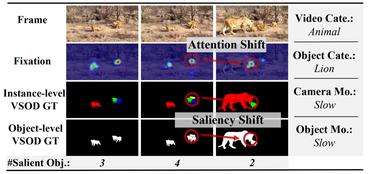Video Salient Object Detection
20 papers with code • 10 benchmarks • 4 datasets
Video salient object detection (VSOD) is significantly essential for understanding the underlying mechanism behind HVS during free-viewing in general and instrumental to a wide range of real-world applications, e.g., video segmentation, video captioning, video compression, autonomous driving, robotic interaction, weakly supervised attention. Besides its academic value and practical significance, VSOD presents great difficulties due to the challenges carried by video data (diverse motion patterns, occlusions, blur, large object deformations, etc.) and the inherent complexity of human visual attention behavior (i.e., selective attention allocation, attention shift) during dynamic scenes. Online benchmark: http://dpfan.net/davsod.
( Image credit: Shifting More Attention to Video Salient Object Detection, CVPR2019-Best Paper Finalist )
Latest papers with no code
Video Salient Object Detection via Fully Convolutional Networks
This paper proposes a deep learning model to efficiently detect salient regions in videos.
Minimum Barrier Salient Object Detection at 80 FPS
Powered by this fast MBD transform algorithm, the proposed salient object detection method runs at 80 FPS, and significantly outperforms previous methods with similar speed on four large benchmark datasets, and achieves comparable or better performance than state-of-the-art methods.
Time-Mapping Using Space-Time Saliency
We describe a new approach for generating regular-speed, low-frame-rate (LFR) video from a high-frame-rate (HFR) input while preserving the important moments in the original.











 FBMS
FBMS
 SegTrack-v2
SegTrack-v2
 FBMS-59
FBMS-59
 ViSal
ViSal